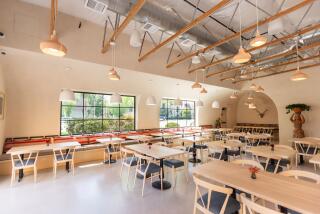Official’s Death Raises Questions : Health: Ventura County community college chancellor, who died from ‘flesh-eating bacteria,’ reportedly did not receive a standard treatment.
THOUSAND OAKS — A medical expert Monday questioned why doctors reportedly never exposed Ventura County’s community college chief, dying from a “flesh-eating bacteria” infection, to one of medicine’s primary defenses against the condition: pure oxygen treatments in a pressurized hyperbaric chamber.
Thomas G. Lakin, 50, chancellor of the Ventura County Community College District, died Sunday at Los Robles Regional Medical Center in Thousand Oaks after a 24-hour medical battle to save his life that included amputating one of his legs.
J.B. Wilmeth, the medical director of the hyperbaric unit at Los Robles, said he only learned of Lakin’s case through a reporter. Though he and the unit’s staff are on emergency call 24 hours a day, he said no one in the unit was informed by hospital staff that a patient with the condition, formally called necrotizing fasciitis, had been admitted.
Typically, he said, patients with the disease are put into the chamber, where doses of oxygen are administered to kill the bacteria and stop it from spreading.
“It’s a little bit shocking that someone could die from that ailment without being sent to our hyperbaric unit,” Wilmeth said when he learned of Lakin’s death.
Wilmeth said Monday that Lakin’s files have not been made available to him, because of the family’s request for privacy.
“I sure would love to know what happened, but I don’t think I’m going to find out any time soon,” he added. “One wonders why, you know, a young man like that. One wonders why the hyperbaric chamber wasn’t considered.”
At the request of Lakin’s family, the medical director of the hospital’s infectious diseases unit would not confirm any specifics of Lakin’s illness, or even that the hyperbaric chamber was not used.
“If indeed it was not used in this case, it must have been because there were circumstances why it could not be,” said Dr. Mark Mazur.
As an example, Mazur said patients with extremely low blood pressure should not be placed in the pressurized chamber, but he would not say whether that was the case with Lakin, a vigorous man who jogged almost every morning and planned to run his 10th Los Angeles Marathon this spring.
“The reasons that people receive one treatment or another have to do with that individual particularly,” Mazur said. “The hyperbaric chamber is felt often to be beneficial, but every case is different.”
The staff at Los Robles has treated a total of six patients with necrotizing fasciitis this year, Wilmeth said. Five of them were given pure oxygen treatments in the hyperbaric chamber to kill the bacteria and survived; Lakin was the sixth.
The Times reported Monday that Lakin’s death appeared to be the first known fatality from flesh-eating bacteria in California, but state officials later estimated that between 14 and 42 deaths from the infection occur annually in California. They said they have no firm figures.
Until recently, health officials did not track cases of the infection, accounting for the uncertainty about deaths. Doctors have known of the condition, caused by a virulent strain of a common streptococcus bacteria, for at least 100 years and can treat the infection with antibiotics. Its flesh-eating properties caught the public’s attention earlier this year after a series of deaths in Britain.
Marilyn Billimek, a Ventura County public health nurse and epidemiologist, said Lakin’s was the first known death in the county due to the flesh-eating bacteria. There were four such deaths in Los Angeles County during the first six months of 1994, said Dr. Laurene Mascola, chief of Los Angeles County’s Acute Communicable Disease Control Unit.
Bob Howard, a spokesman for the Centers for Disease Control and Prevention in Atlanta, said it is estimated that there are 150 to 300 deaths from flesh-eating bacteria annually nationwide.
Lakin’s sudden death left students and faculty shaken at the three community college campuses in Ventura County. Flags were flown at half-staff Monday, and administrators spent much of the day debating how to replace Lakin, a popular chancellor whom many credit with leading the 28,000-student district away from the brink of budgetary and organizational chaos.
Colleagues at Los Angeles Southwest College, where Lakin served as president for five years, were also shocked by his sudden death. They recall Lakin revitalizing the school, pumping new life into everything from the community outreach programs to the football team and flower beds.
Lakin had complained to colleagues about a severe sore throat Wednesday. Friends said he waited until Friday to go to the Los Robles emergency room.
Physician Mazur would not comment on what treatment Lakin received that day, but friends said he was treated for symptoms of strep throat, then released.
On Saturday, Lakin returned to the emergency room, saying that he had a sharp pain in his leg and that the tenderness in his throat had not improved. He was admitted to the hospital. Within hours, the disease “spread like wildfire,” friends said.
“He was unconscious a great portion of the time,” said one source close to the family. “He went in for exploratory surgery before the amputation of his leg and never regained consciousness.”
Again, Mazur declined to comment on the specifics of Lakin’s treatment, but did say amputation is a common treatment in such cases.
Times staff writer Carlos Lozano and correspondents Jeff McDonald and Matt Mosk contributed to this story.
More to Read
Sign up for Essential California
The most important California stories and recommendations in your inbox every morning.
You may occasionally receive promotional content from the Los Angeles Times.










